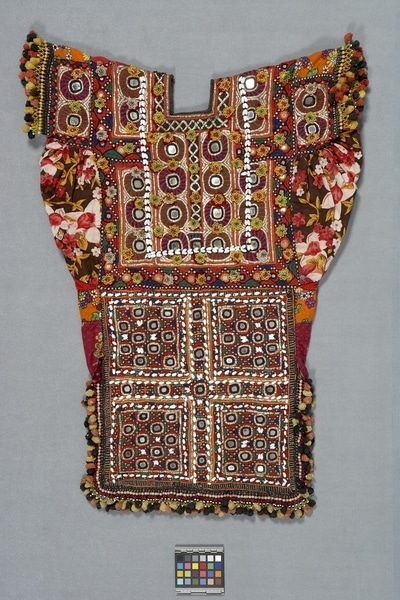Backless Blouse Item Number: 1098/7 from the MOA: University of British Columbia


Description
Woman’s backless blouse, made from several large, very elaborately embroidered, multi-coloured panels. The top portion of the blouse is embellished with circular motifs, large clusters of yellow, red and green glass beads and mirrorwork; a large rectangular portion is outlined with small white cowrie shells to form a bib effect. The neckline is high and squared; it fastens at the centre back with cloth ties made from printed cotton textile. Below the waist, an embroidered rectangular panel is divided into four squares, each embroidered with mirrors and geometric shapes; each square is outlined with small white cowrie shells. Over-all, many of the designs are outlined with a silver “braid” formed by tightly coiling a very narrow ribbon of metal into a long strip, which is attached to the surface with a couching stitch. The hem and sides, as well as the sleeve edges, are bordered with black embroidery, white rickrack and many small tassels made from yellow and green beads and black, yellow and orange pompoms. Back shoulder yokes, underarm gussets and narrow side panels are pieced from brightly coloured, machine-printed cotton textiles. The embroidery is underlined with red and multi-coloured printed cotton gauze. A pocket made from green striped cotton textile is attached on the inside at the lower right-hand side.
History Of Use
Backless blouses are worn with a long, gathered skirt or baggy pants as part of the everyday or festive costume. A veil is worn over the head and shoulders, covering the back. An embroidered blouse front like this one is called a “greban” in Threadlines Pakistan, but the term “gaj” is used in Colours of the Indus (see References). “Gaj” is also spelled “guj” in the literature. The hang tag that was attached to the blouse at the time of purchase in Pakistan calls it an “greban old.”
Specific Techniques
couching stitch; chain stitch; satin stitch; buttonhole stitch
Cultural Context
domestic
Narrative
This blouse was purchased by William McLennan at Threadlines Gallery in Islamabad, Pakistan, in 1985 while he was on assignment for the Museum of Anthropology, which had a contract with the administration of Expo ‘86 to set up the Pakistan pavilion at the fair. The Museum purchased it, along with the other items in the 1098 accession, from McLennan in 1986.
Item History
- Made in Sindh, Pakistan ? before September 1985
- Collected by Bill McLennan during 1985
- Owned by Bill McLennan between September 1985 and January 30, 1986
- Received from Bill McLennan (Seller) and Museum of Anthropology Shop Volunteers (Funding source) on January 30, 1986
What
- Name
- Backless Blouse
- Identification Number
- 1098/7
- Type of Item
- blouse
- Material
- cotton fibre, silk fibre, glass, cowrie shell ?, silver alloy metal and dye
- Manufacturing Technique
- embroidered, beaded and sewn
- Overall
- height 76.0 cm, width 54.0 cm
Who
- Culture
- South Asian
- Field Collector
- Bill McLennan
- Previous Owner
- Bill McLennan
- Received from
- Bill McLennan (Seller) and Museum of Anthropology Shop Volunteers (Funding source)
Where
- Holding Institution
- MOA: University of British Columbia
- Made in
- Sindh, Pakistan ?
When
- Creation Date
- before September 1985
- Collection Date
- during 1985
- Ownership Date
- between September 1985 and January 30, 1986
- Acquisition Date
- on January 30, 1986
Other
- Item Classes
- textiles
- Condition
- good
- Accession Number
- 1098/0007